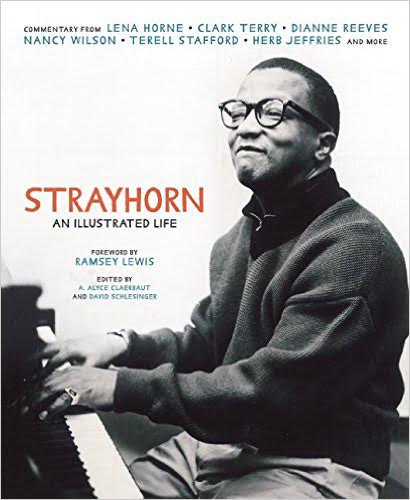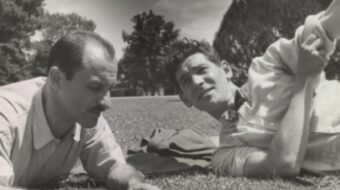
Billy Strayhorn’s name remains forever linked to bandleader Duke Ellington and His Orchestra. The African-American composer, arranger, lyricist, and pianist thrived creatively after joining Ellington in 1939. Born in Dayton, Ohio, and raised in Pittsburgh, Strayhorn was one of America’s most talented composers, but often overshadowed by the presence of Ellington. The two legendary talents combined efforts to create some of the most popular Big Band classics of all time, including “Take the ‘A’ Train” and “Satin Doll.”
Though immensely admired among fellow musicians, the public rarely contemplated his individuality beyond Ellington’s band. It’s true he attained success during his 28-year collaboration with Ellington, but there was much more to this artist. An aura of determination graced Strayhorn’s life. His story is featured in a new oversized volume that has been released in conjunction with the centennial of his birth.
“Strayhorn: An Illustrated Life” is a treasure of essays, interviews, sheet music, and photography showcasing his life and career. Strayhorn managed to rise above each of his personal challenges. The book describes Pittsburgh as not the harshest environment for an African-American youth, but there remained prejudice to confront. The fact that Billy Strayhorn was also a young gay man coming of age in the 1930s underlines the hurdles he encountered overcoming social bias. His uncompromisingly sophisticated talent began in his teen years. Jazz musicologist Walter van de Leur comments in his liner notes, “That a youngster from one of Pittsburgh’s poorest and most depressing neighborhoods came up with ‘Lush Life,’ one of jazz’s most beloved ballads, is baffling.”
Billy Strayhorn’s life changed on December 1, 1938 at the Stanley Theatre in Pittsburgh where Duke Ellington was performing. A local friend set up a meeting between the two and an impressed Ellington hired Strayhorn into his band. Strayhorn moved to New York City and spent the next three decades composing for Ellington and touring the world. The young man with humble beginnings was now on top of the world, but never let it change his compassion. There are numerous testimonies from friends, family, and fellow musicians of his endless generosity.
“Strayhorn: An Illustrated Life” is a collaborative effort produced by Billy Strayhorn Songs, Inc. (BSSI). This is a family-based organization that attempts to preserve and perpetuate the legacy of one of America’s finest composers. In 1967 upon the death of Mr. Strayhorn, his nephew, Gregory A. Morris, became executor of his estate. In the following years many previously unreleased works by Strayhorn have been shared with the public through Morris and BSSI. The book begins with a proper introduction by jazz legend Ramsey Lewis. It is then divided into two sections. Part One is titled “Musical Orbits.”
This section, written by Strayhorn’s niece A. Alyce Claerbaut, reflects on his artistic success and his dedication to family and friends along the way. Singer Lena Horne was one of his closest companions and the two became soulmates. We also learn of Strayhorn’s personal relationships, including time spent with partners African-American musician Aaron Bridgers, and later Bill Grove.
“Moral Freedoms,” the second half of the book, is written by Bruce Mayhall Rastrelli. This section explains how Billy Strayhorn remained true to his ideals not only musically, but culturally and socially. Readers will discover that civil rights were as much a part of Strayhorn as his composing. Mr. Strayhorn was open about his sexuality, which was decidedly uncommon in that era. Mercedes Ellington (Duke’s granddaughter) states, “It was very dangerous then to be a homosexual – male or female.” Music publisher Herb Jordan adds, “If you dealt with Billy Strayhorn you had to accept him as he was or not at all, and that again was revolutionary for that period.”
Billy Strayhorn was a dedicated contributor to the cause of freedom and became a poster idol for the NAACP voter registration campaigns in the 1940s. Strayhorn also formed a strong relationship with Dr. Martin Luther King, Jr. Musically, he collaborated with Duke Ellington for a series of civil rights shows, including “My People,” a stage show presented in Chicago as part of the Century of Negro Progress Exposition in 1963. On June 7, 1963, Billy Strayhorn accompanied Lena Horne in a concert in Jackson, Miss., in support of civil rights. While traveling South, they stopped in Atlanta to meet with Julian Bond and make a donation to the Student Nonviolent Coordinating Committee (SNCC).
“Strayhorn: An Illustrated Life” is a welcome addition for anyone interested in jazz, civil rights, or photography. It is edited by A. Alyce Claerbaut and David Schlesinger. Strayhorn’s biographer David Hajdu and filmmaker Robert Levi contribute interviews and insights from his fellow musicians. Billy Strayhorn was born November 29, 1915: This book is a fine tribute in his centenary year. In Strayhorn’s own words, “Ever up and onward!”
“Strayhorn: An Illustrated Life”
Publisher: Agate Bolden
Available in Hardcover and Kindle editions










